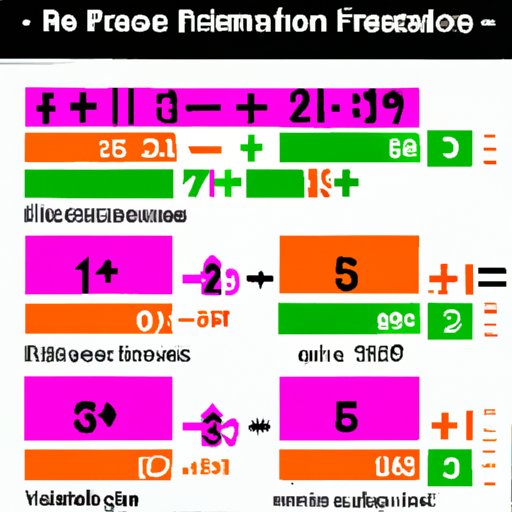
How to Reduce Fractions: Simplify Your Math Life
Understanding fractions is an essential concept in the world of math. Whether it’s for basic arithmetic, algebraic equations, or even everyday tasks like cooking or carpentry, fractions play a significant role in our daily lives. Reducing fractions is an important skill that can simplify mathematical calculations, making it easier to solve problems. In this article, we will explain how to reduce fractions, step-by-step, to their simplest form. We will also cover common mistakes and misconceptions, alternative methods for reducing fractions, and the practical applications of reducing fractions.
Understanding Fractions and Reduction
A fraction is a mathematical expression that represents a part-to-whole relationship. Fractions are used to describe portions of an object or a quantity, such as you ate 3/4 of a pizza. Reducing a fraction means simplifying it to its lowest form, so that the numerator (the top number) and denominator (the bottom number) have no factors in common besides 1. This makes it easier to work with fractions, particularly when calculating with them.
For example, let’s look at the fraction 12/16. This fraction can be reduced to its simplest form by dividing both the numerator and denominator by a common factor, which is 4. After simplification, we get 3/4, which is equivalent to the original fraction but simpler to work with.
Some common misconceptions about reducing fractions are that the reduced fraction is always smaller than the original fraction or that reducing fractions requires complex calculations. However, this is not the case, as reducing fractions only involves finding common factors and dividing both the numerator and denominator by those factors until the fraction can no longer be simplified.
Steps for Reducing Fractions
The process of reducing fractions has a few simple steps:
- Find the greatest common factor (GCF) of the numerator and the denominator.
- Divide both the numerator and the denominator by the GCF.
- If the numerator and denominator have any common factor besides 1 after the last step, repeat step 1 and step 2 until the fraction can no longer be simplified.
Let’s use the fraction 24/36 as an example to demonstrate these steps. Firstly, we need to find the GCF of 24 and 36, which is 12. Next, we divide both the numerator and denominator by 12, giving us the new fraction of 2/3. As 2 and 3 do not have any common factors other than 1, this is the lowest form of the fraction.
Here are some practice problems for you to try on your own:
- 30/45
- 16/24
- 25/35
Remember, always simplify fractions to their lowest form as much as possible.
Common Mistakes and How to Avoid Them
Some of the common errors when reducing fractions include forgetting to simplify the fraction to its lowest form or dividing the numerator and the denominator by the wrong factor. One of the best strategies to avoid these mistakes is to double-check your answer by multiplying the numerator and denominator back together to see if they equal the original fraction.
Let’s use an example of the fraction 16/24. If we divide both the numerator and denominator by 6, we get the fraction 8/12. However, when we multiply 8 by 3 and 12 by 2, we get 24/36, which is not equal to the original fraction. This means that we have simplified the fraction incorrectly, and we need to go back and find the correct factor to divide by.
Different Methods for Reducing Fractions
While the three-step process above is the most commonly used method for reducing fractions, there exist other approaches as well. For instance, finding the greatest common divisor of the two numbers is an alternative method. You can input the two numbers into a calculator, or, if you want to go about it manually, list the divisors, or factors, of each number and include the ones that are in common. Dividing the numerator and the denominator by the greatest common divisor will create the simplified fraction in their lowest terms.
The Division method involves repeatedly dividing the denominator by the numerator, then the remainder by the number of prior numerator, and so on. The last non-zero remainder is the greatest common divisor. Then, the simplified fraction can be calculated by dividing the numerator and the denominator by the GCD.
The Importance of Reducing Fractions in Math and Beyond
Reducing fractions has various practical applications in math. Reducing fractions is helpful when adding or subtracting fractions or solving algebraic equations. It also helps when we need to compare two fractions. For instance, to compare the magnitudes of the fractions 5/6 and 3/4, we first reduce 5/6 to its simplest form of 5/6. Now, we may compare the numerators of both fractions since both their denominators are equal (6). It is clear that 5/6 is greater than 3/4.
Besides math, reducing fractions is useful in everyday situations, such as cooking or carpentry. If a recipe calls for 3/4 of a cup of flour, you may want to reduce that quantity to 1/2 a cup of flour. By doing this, it’s not only easier but also more convenient for you to measure the ingredient out.
Additional Resources for Reducing Fractions
Finally, suppose you need some extra help. In that case, several online resources are available that can help you improve your understanding of reducing fractions. For example, you can watch YouTube videos or download worksheets for your practice.
Conclusion
Reducing fractions is an essential skill that can help you simplify math problems and make them easier to work with. By following the steps described in this article, you can simplify fractions to their simplest form. Remember to pay attention to common mistakes, experiment with alternative methods, and apply the concept in practical situations to develop your understanding truly.
Now that you have acquired new knowledge, practice repeatedly until it becomes second nature.





